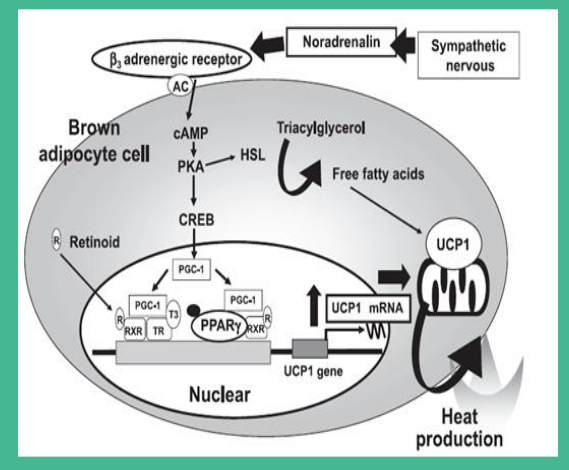
Fucoxanthins most peculiar weight loss mechanism
Biological activity against obesity and metabolic syndrome:
Lower triglycerides and cholesterol: Fucoxanthin through down-regulation of low-density lipoprotein (LDL) receptors and scavenger receptor class B member 1 (SR-B1)
Inhibition of fat synthesis: Fucoxanthin also reduces the mRNA expression of fatty acid synthase (FAS), which catalyzes fatty acid synthesis.
Inhibition of glucose absorption: Fucoxanthin also inhibits the uptake of glucose by mature adipocytes by reducing the phosphorylation of insulin receptor substrate 1 (IRS-1).
Regulating lipid metabolism genes: Fucoxanthin significantly reduces the activity of cholesterol-regulating enzymes such as acyl-CoA, and affects the expression of genes related to lipid metabolism.
Reduce the volume of fat cells: Fucoxanthin can reduce the expression of triglyceride (TG) in fat cells.
Anti-obesity pathways and mechanisms
(a) In muscle tissue: fucoxanthin promotes heat production and avoids fat production.
(b) In white adipose tissue: Fucoxanthin activates Uncoupling Protein-1 (UCP1), increases heat production, and promotes the breakdown of white fat. That is, through the oxidation and heat production of fatty acids in white adipose tissue, the purpose of energy consumption is achieved.
Nutrigenomic studies have shown that fucoxanthin can induce uncoupling protein-1 (UCP1) in the mitochondria of abdominal wall white adipose tissue, up-regulate the expression of uncoupling protein-1, through fatty acid oxidation and thermogenesis in white adipose tissue , to achieve the purpose of consuming energy.

Mechanism of action for energy expenditure in brown adipocytes through activation of uncoupling protein-1 (UCP1) expression. Fucoxanthin can promote the transformation of white fat into brown adipose tissue, thereby accelerating the decomposition of fat in the body.

Resting Energy Expenditure (REE) is used to describe the calories a person burns in a day without any strenuous exercise.
When food energy causes a nutrient surplus, energy expenditure relies on thermogenic functional pathways through adipose tissue. A reduction in energy expenditure may increase the risk of obesity.
One of the key regulators of energy balance is the uncoupling protein (UCP), which can uncouple the respiratory chain from the ATP production process, so that the energy generated during the oxidation of the substrate is dissipated in the form of heat instead of in the gland. stored in the form of glycoside triphosphate (ATP). UCP plays an important role in energy metabolism.
Static Fat Burning: Fucoxanthin's most peculiar weight loss mechanism
A comparison of the normal physique population and obese individuals with low resting energy expenditure found that there is a significant difference between the uncoupling protein UCP and the resting energy expenditure (REE). Obese subjects had significantly lower measured resting energy expenditure than the other groups.
Fucoxanthin activates Uncoupling Protein-1 ( UCP1 ), increasing heat production. Through the intake and metabolism of fucoxanthin, obese people can increase the calories consumed in a day without strenuous exercise, and achieve the purpose of fat loss and weight control.
